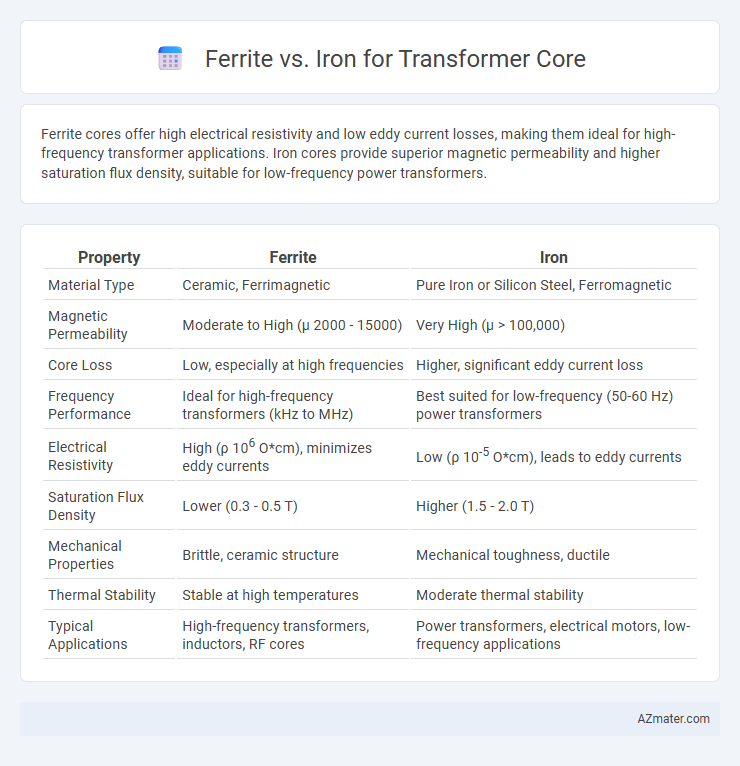Ferrite cores offer high electrical resistivity and low eddy current losses, making them ideal for high-frequency transformer applications. Iron cores provide superior magnetic permeability and higher saturation flux density, suitable for low-frequency power transformers.
Table of Comparison
| Property | Ferrite | Iron |
|---|---|---|
| Material Type | Ceramic, Ferrimagnetic | Pure Iron or Silicon Steel, Ferromagnetic |
| Magnetic Permeability | Moderate to High (μ 2000 - 15000) | Very High (μ > 100,000) |
| Core Loss | Low, especially at high frequencies | Higher, significant eddy current loss |
| Frequency Performance | Ideal for high-frequency transformers (kHz to MHz) | Best suited for low-frequency (50-60 Hz) power transformers |
| Electrical Resistivity | High (ρ 106 O*cm), minimizes eddy currents | Low (ρ 10-5 O*cm), leads to eddy currents |
| Saturation Flux Density | Lower (0.3 - 0.5 T) | Higher (1.5 - 2.0 T) |
| Mechanical Properties | Brittle, ceramic structure | Mechanical toughness, ductile |
| Thermal Stability | Stable at high temperatures | Moderate thermal stability |
| Typical Applications | High-frequency transformers, inductors, RF cores | Power transformers, electrical motors, low-frequency applications |
Introduction: Understanding Transformer Core Materials
Ferrite cores and iron cores are fundamental materials used in transformer construction, each offering distinct magnetic properties affecting performance and efficiency. Ferrite cores, composed of ceramic-like compounds, exhibit high electrical resistivity and low eddy current losses, making them ideal for high-frequency applications. In contrast, iron cores, typically made from laminated silicon steel, provide superior magnetic permeability, supporting higher power ratings and efficient low-frequency operation.
What is Ferrite? Properties and Composition
Ferrite is a ceramic-like magnetic material composed primarily of iron oxide combined with metallic elements such as manganese, zinc, or nickel, creating a ferrimagnetic compound ideal for transformer cores. Its high electrical resistivity significantly reduces eddy current losses, making it efficient for high-frequency applications compared to pure iron cores. Ferrite cores exhibit low coercivity, high permeability, and excellent magnetic stability, which contribute to improved energy efficiency and reduced heat generation in transformers.
What is Iron? Properties and Types Used in Cores
Iron is a ferromagnetic metal commonly used in transformer cores due to its high magnetic permeability and ability to efficiently conduct magnetic flux. It exists primarily as pure iron or alloyed forms such as silicon steel, which reduces eddy current losses and improves electrical resistivity. Grain-oriented silicon steel and non-oriented silicon steel are typical core materials, selected based on their magnetic properties and operational frequency requirements.
Magnetic Permeability: Ferrite vs Iron
Ferrite cores exhibit lower magnetic permeability compared to iron cores, typically ranging from 2000 to 15,000, while iron cores can have permeability values exceeding 100,000. This difference results from ferrite's ceramic-like structure, which causes higher magnetic reluctance but reduced eddy current losses at high frequencies. Iron cores, with higher permeability, are preferred in low-frequency transformers for better magnetic flux conduction and energy efficiency.
Core Losses: Comparing Eddy Currents and Hysteresis
Ferrite transformer cores exhibit significantly lower core losses than iron cores due to their higher electrical resistivity, which reduces eddy current losses effectively. Iron cores experience greater hysteresis losses because of their larger magnetic domains and lower coercivity compared to ferrite materials. Optimizing transformer performance often involves selecting ferrite cores in high-frequency applications to minimize combined core losses and improve energy efficiency.
Frequency Response: Suitability for High and Low Frequencies
Ferrite cores exhibit superior frequency response at high frequencies, typically above 20 kHz, due to their low eddy current losses and high electrical resistivity, making them ideal for switching power supplies and high-frequency transformers. Iron cores, often made from laminated silicon steel, perform better at low frequencies, usually below 20 kHz, because of their higher magnetic flux density and lower core losses under these conditions. The choice between ferrite and iron cores hinges on the transformer's operational frequency range, with ferrite cores preferred for high-frequency applications and iron cores for low-frequency, power distribution transformers.
Efficiency and Performance in Transformers
Ferrite cores exhibit higher magnetic permeability and lower core losses at high frequencies compared to iron cores, enhancing transformer efficiency in switching power supplies and high-frequency applications. Iron cores, typically silicon steel laminations, offer superior saturation flux density, enabling higher power handling but suffer from increased hysteresis and eddy current losses at elevated frequencies. Choosing ferrite cores improves performance by minimizing energy losses and heat generation in high-frequency transformers, while iron cores remain favored for low-frequency, high-power transformers due to their robustness and cost-effectiveness.
Applications: When to Use Ferrite or Iron Cores
Ferrite cores are ideal for high-frequency applications such as switching power supplies, RF transformers, and inductors due to their low eddy current losses and high electrical resistivity. Iron cores, including laminated silicon steel, are better suited for low-frequency applications like power transformers and large inductors because they provide higher magnetic permeability and saturation flux density. Selecting ferrite or iron cores depends largely on operating frequency, power efficiency, and thermal performance requirements.
Cost and Availability Considerations
Ferrite cores generally offer lower costs for high-frequency transformers due to their efficient magnetic properties and ease of manufacturing in mass production. Iron cores, typically made from laminated silicon steel, have higher material and processing expenses but are widely available and preferred for low-frequency applications like power transformers. Availability of ferrite cores may be limited in large sizes, while iron cores benefit from established global supply chains, influencing overall project budgeting and component sourcing.
Conclusion: Choosing the Right Core Material
Ferrite cores excel in high-frequency transformer applications due to their low eddy current losses and high electrical resistivity, making them ideal for switching power supplies and RF transformers. Iron cores, particularly laminated silicon steel, provide superior magnetic flux density and are preferred in low-frequency, high-power transformers such as those in power distribution. Selecting the right core material depends on frequency, efficiency requirements, power levels, and cost constraints to optimize transformer performance and minimize energy losses.

Infographic: Ferrite vs Iron for Transformer core
 azmater.com
azmater.com